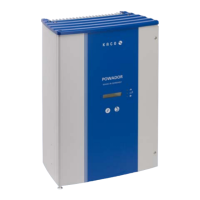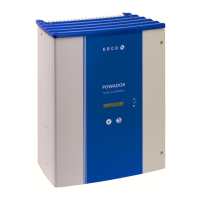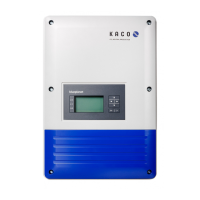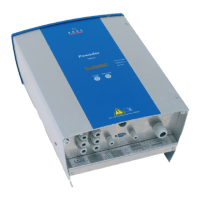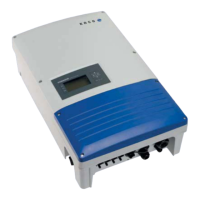Do you have a question about the Kaco Powador and is the answer not in the manual?
Instructions for installation and safe use of the inverter. Must be read before operation.
Explains symbols and safety warning guides used in the manual for clear understanding.
Explains NOTE and country-specific function symbols used in the document.
Details symbols used for prerequisites, steps, and results in instructions.
Defines the intended use of the inverter and lists improper applications that may cause hazards.
Lists integrated monitoring and protective functions for user safety.
Explains how the inverter converts DC to AC and feeds it into the grid.
Illustrates the main components of the inverter with a key.
Provides detailed electrical specifications including input/output levels and general data.
Details the physical dimensions, weight, interfaces, and environmental ratings of the inverter.
Information on the inverter's condition upon leaving the factory and responsibility for transport damage.
Step-by-step instructions for unpacking the inverter and checking for delivery damage.
Guidelines for safely positioning and securing the inverter to prevent tipping hazards.
Requirements for the installation environment, including climate control and ventilation.
Specifies requirements for mounting surfaces, including load capacity and material properties.
Details required clearances around the inverter to ensure proper ventilation and prevent performance reduction.
Instructions for drilling holes and physically securing the inverter to the mounting surface.
Steps for fitting the left and right housing covers onto the inverter unit.
Instructions for installing the EMC sheet metal for electromagnetic compatibility.
Guidance on routing electrical lines through the inverter housing using pre-punched perforations.
Details on connecting AC and DC cables to the inverter's PCB terminals, including cable cross-sections.
Step-by-step instructions for connecting the inverter to the AC grid using various terminal configurations.
Specific instructions for making the grid connection using a 5-core cable in a TN-S system.
Instructions for connecting the PV generator to the inverter, including safety precautions.
Essential checks to ensure no ground fault and proper insulation resistance before connecting the PV generator.
Specific connection guidelines for XL variants, including fuse types and electrical data.
Instructions for connecting communication interfaces like Ethernet, USB, and RS485 to the inverter.
Details on the connection area for interfaces and specific connection steps.
Procedure for connecting the fault signal relay contact to external devices.
Instructions for connecting the S0 pulse output for accessory control, like large displays.
Guidance on connecting the RS485 bus for communication, including wiring and termination.
Visual representation of the RS485 interface wiring connections for the inverter.
Steps to activate the RS485 terminating resistor via the inverter's settings menu.
Instructions for connecting the digital input for remote shutdown of the inverter.
Steps for powering on the inverter after installation, including connecting grid voltage and PV generator.
Overview of the inverter's control panel, including buttons, LEDs, and the LCD display.
Explanation of the status indicated by the green and red LEDs on the inverter's front panel.
Description of the inverter's LCD display, showing measurements, yield, and status information.
Detailed guide on operating the inverter using the 4-way button, OK, and ESC buttons.
Steps for the initial configuration of the inverter using the configuration assistant.
Overview of the inverter's menu hierarchy and navigation system.
Explanation of the main menu display and its components.
Detailed breakdown of menu items, settings, and actions based on country and device type.
Accessing and navigating the inverter's settings menu for various configurations.
Option to select the desired language for the user interface.
Configuration options for communication interfaces like RS485 and SO pulse rate.
Settings related to display contrast, backlight timeout, and permanent activation.
Configuration of network settings including DHCP, IP address, subnet mask, gateway, and DNS server.
Accessing advanced parameters, including country settings and grid type selection.
Setting the inverter's country-specific operating parameters.
Selecting the appropriate grid type for the inverter's installation location.
Setting the switch-off value for voltage drop based on grid standards.
Configuring shutdown thresholds for undervoltage conditions.
Setting shutdown limits for overfrequency conditions.
Setting a lower maximum output power to comply with grid operator requests.
Configuring support for grid shutdown via a Powador-protect system.
Settings for dynamic grid stabilization features like Fault Ride-Through.
Configuring power factor settings for idle power control.
Setting voltage thresholds for network support processes.
Specifying the number of support points for the idle power characteristic curve.
Accessing information about the inverter, including type, software version, and serial number.
Displaying the inverter's type designation and maximum output power.
Displaying the unique serial number of the inverter.
Using a USB storage device to read operating data saved in the inverter.
Accessing the inverter's web server via an Internet browser for monitoring and data retrieval.
Instructions for configuring the Ethernet interface and activating the web server.
Steps to access the inverter's web server through an Internet browser.
Procedures for selecting and exporting recorded measurement and yield data from the web server.
Guide on updating the inverter's software using a USB interface.
Instructions for visually inspecting the inverter and cables for damage.
Guidelines for cleaning the exterior of the inverter safely.
Critical steps for safely shutting down the inverter before performing maintenance.
Information on identifying and diagnosing faults in the inverter and grid connection.
General procedure for handling faults, including notifying service personnel.
A table detailing common faults, their causes, and remedies.
Explanation of fault messages displayed on the inverter's screen and LEDs.
Overview of how status and fault messages are presented on the display and LEDs.
A detailed list of status (OS) and fault (FS) signals with their explanations and required actions.
Contact information for technical support and customer service for KACO products.
Steps for safely shutting down the inverter before any disassembly.
Instructions for safely uninstalling the inverter from its mounting.
Safety precautions and steps for dismantling the inverter after uninstallation.
Document confirming the inverter's compliance with EU directives and relevant safety standards.
Instructions for installation and safe use of the inverter. Must be read before operation.
Explains symbols and safety warning guides used in the manual for clear understanding.
Explains NOTE and country-specific function symbols used in the document.
Details symbols used for prerequisites, steps, and results in instructions.
Defines the intended use of the inverter and lists improper applications that may cause hazards.
Lists integrated monitoring and protective functions for user safety.
Explains how the inverter converts DC to AC and feeds it into the grid.
Illustrates the main components of the inverter with a key.
Provides detailed electrical specifications including input/output levels and general data.
Details the physical dimensions, weight, interfaces, and environmental ratings of the inverter.
Information on the inverter's condition upon leaving the factory and responsibility for transport damage.
Step-by-step instructions for unpacking the inverter and checking for delivery damage.
Guidelines for safely positioning and securing the inverter to prevent tipping hazards.
Requirements for the installation environment, including climate control and ventilation.
Specifies requirements for mounting surfaces, including load capacity and material properties.
Details required clearances around the inverter to ensure proper ventilation and prevent performance reduction.
Instructions for drilling holes and physically securing the inverter to the mounting surface.
Steps for fitting the left and right housing covers onto the inverter unit.
Instructions for installing the EMC sheet metal for electromagnetic compatibility.
Guidance on routing electrical lines through the inverter housing using pre-punched perforations.
Details on connecting AC and DC cables to the inverter's PCB terminals, including cable cross-sections.
Step-by-step instructions for connecting the inverter to the AC grid using various terminal configurations.
Specific instructions for making the grid connection using a 5-core cable in a TN-S system.
Instructions for connecting the PV generator to the inverter, including safety precautions.
Essential checks to ensure no ground fault and proper insulation resistance before connecting the PV generator.
Specific connection guidelines for XL variants, including fuse types and electrical data.
Instructions for connecting communication interfaces like Ethernet, USB, and RS485 to the inverter.
Details on the connection area for interfaces and specific connection steps.
Procedure for connecting the fault signal relay contact to external devices.
Instructions for connecting the S0 pulse output for accessory control, like large displays.
Guidance on connecting the RS485 bus for communication, including wiring and termination.
Visual representation of the RS485 interface wiring connections for the inverter.
Steps to activate the RS485 terminating resistor via the inverter's settings menu.
Instructions for connecting the digital input for remote shutdown of the inverter.
Steps for powering on the inverter after installation, including connecting grid voltage and PV generator.
Overview of the inverter's control panel, including buttons, LEDs, and the LCD display.
Explanation of the status indicated by the green and red LEDs on the inverter's front panel.
Description of the inverter's LCD display, showing measurements, yield, and status information.
Detailed guide on operating the inverter using the 4-way button, OK, and ESC buttons.
Steps for the initial configuration of the inverter using the configuration assistant.
Overview of the inverter's menu hierarchy and navigation system.
Explanation of the main menu display and its components.
Detailed breakdown of menu items, settings, and actions based on country and device type.
Accessing and navigating the inverter's settings menu for various configurations.
Option to select the desired language for the user interface.
Configuration options for communication interfaces like RS485 and SO pulse rate.
Settings related to display contrast, backlight timeout, and permanent activation.
Configuration of network settings including DHCP, IP address, subnet mask, gateway, and DNS server.
Accessing advanced parameters, including country settings and grid type selection.
Setting the inverter's country-specific operating parameters.
Selecting the appropriate grid type for the inverter's installation location.
Setting the switch-off value for voltage drop based on grid standards.
Configuring shutdown thresholds for undervoltage conditions.
Setting shutdown limits for overfrequency conditions.
Setting a lower maximum output power to comply with grid operator requests.
Configuring support for grid shutdown via a Powador-protect system.
Settings for dynamic grid stabilization features like Fault Ride-Through.
Configuring power factor settings for idle power control.
Setting voltage thresholds for network support processes.
Specifying the number of support points for the idle power characteristic curve.
Accessing information about the inverter, including type, software version, and serial number.
Displaying the inverter's type designation and maximum output power.
Displaying the unique serial number of the inverter.
Using a USB storage device to read operating data saved in the inverter.
Accessing the inverter's web server via an Internet browser for monitoring and data retrieval.
Instructions for configuring the Ethernet interface and activating the web server.
Steps to access the inverter's web server through an Internet browser.
Procedures for selecting and exporting recorded measurement and yield data from the web server.
Guide on updating the inverter's software using a USB interface.
Instructions for visually inspecting the inverter and cables for damage.
Guidelines for cleaning the exterior of the inverter safely.
Critical steps for safely shutting down the inverter before performing maintenance.
Information on identifying and diagnosing faults in the inverter and grid connection.
General procedure for handling faults, including notifying service personnel.
A table detailing common faults, their causes, and remedies.
Explanation of fault messages displayed on the inverter's screen and LEDs.
Overview of how status and fault messages are presented on the display and LEDs.
A detailed list of status (OS) and fault (FS) signals with their explanations and required actions.
Contact information for technical support and customer service for KACO products.
Steps for safely shutting down the inverter before any disassembly.
Instructions for safely uninstalling the inverter from its mounting.
Safety precautions and steps for dismantling the inverter after uninstallation.
Document confirming the inverter's compliance with EU directives and relevant safety standards.

